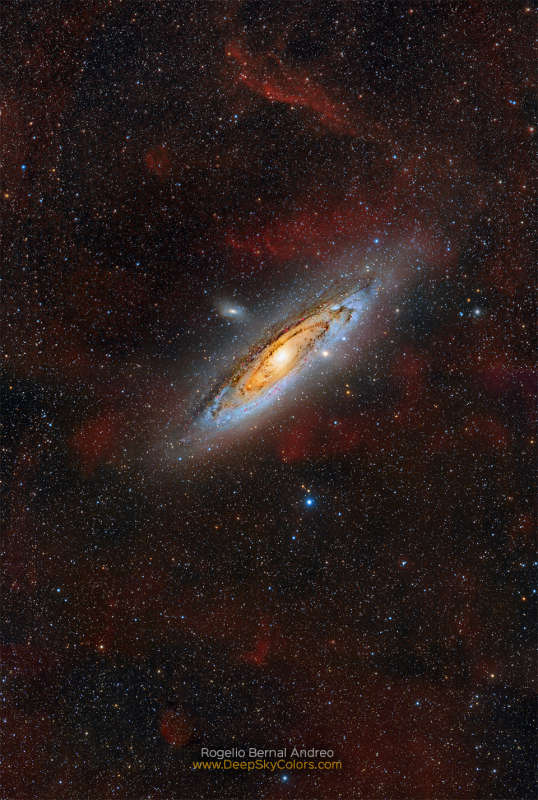
|
Credit & Copyright: Rogelio Bernal
Andreo (Deep Sky Colors)
Explanation:
The beautiful Andromeda Galaxy is often imaged by
planet Earth-based astronomers.
Also known as M31, the nearest large spiral galaxy is a familiar sight
with dark dust lanes, bright yellowish core, and
spiral arms traced by
blue starlight.
A mosaic of well-exposed broad and narrow-band image data, this
colorful,
premier portrait of our
neighboring island universe
offers strikingly unfamiliar
features though, faint reddish clouds of glowing
ionized hydrogen gas in the same wide field of view.
Still, the ionized hydrogen clouds likely
lie in the foreground of the scene, well within our Milky Way Galaxy.
They could be associated with the pervasive, dusty
interstellar cirrus
clouds scattered hundreds of light-years above our own galactic plane.
If they were located at the 2.5 million light-year distance of the
Andromeda Galaxy they would be enormous,
since the Andromeda Galaxy itself is 200,000 or so light-years across.
APOD Lecture: Friday, Jan. 6,
Amateur Astronomers Association of New York City
|
January February March April May June July August September October November December |
| |||||||||||||||||||||||||||||||||||||||||||||||||||||||
NASA Web Site Statements, Warnings, and Disclaimers
NASA Official: Jay Norris. Specific rights apply.
A service of: LHEA at NASA / GSFC
& Michigan Tech. U.
Based on Astronomy Picture
Of the Day
Publications with keywords: M 31 - hydrogen
Publications with words: M 31 - hydrogen
See also:
- APOD: 2025 August 6 Á Meteor before Galaxy
- Hubble s Andromeda Galaxy Mosaic
- NGC 206 and the Star Clouds of Andromeda
- APOD: 2024 September 8 Á M31: The Andromeda Galaxy
- APOD: 2023 November 13 Á Andromeda over the Alps
- The Once and Future Stars of Andromeda
- APOD: 2023 August 23 Á The Meteor and the Galaxy
